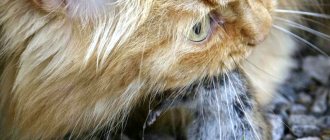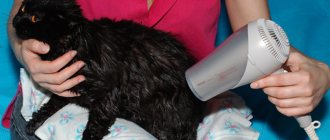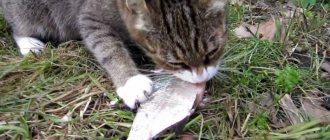Unfortunately, the owners of many animals do not know how to properly care for them. They believe that the cat should be well-fed, healthy and toilet trained. The rest is the imagination of veterinarians and a waste of time. After all, somehow cats live on the street and no one cuts them, scratches them or bathes them. This is actually a misconception. After all, most breeds are bred artificially by man. As a result, such animals get sick more often and are less independent. Long-haired cats should definitely be combed, since they cannot cope with this process on their own. Other breeds need periodic bathing, nail trimming, etc. Therefore, the correct answer to the question “do cats need to have their ears cleaned” is yes. But how often to do this depends on the breed, health status, living conditions and character of the particular animal.
How often should you clean your pet's ears?
Cats should be accustomed to regular examinations and ear cleaning from an early age, since the animal’s protests can add undesirable variety to the manipulations.
Specially produced care products are used to clean the ears:
- cleansing wet wipes - remove dirt well, are easy to use, especially convenient on the road;
- hygiene lotions - may contain both antiseptics and vegetable oils and extracts;
- hygienic ear drops - contain boric or salicylic acid, as well as plant extracts; buried shallowly in the external auditory canal in the dosage prescribed by the instructions, the ear is massaged;
- gels for ear care - also contain antiseptics and herbal ingredients;
- powder - contains iodoform, helps relieve irritation and prevents the growth of microflora; but veterinarians believe that the use of powder leads to the formation of sulfur plugs.
First you need to prepare the necessary equipment. These include:
- cotton buds;
- cotton pads;
- specialized solutions.
Next, the pet is restrained so that it does not escape. Otherwise, you may injure your ear due to careless movements. If the cat has a violent disposition, then it is better to carry out the hygiene procedure with an assistant. It is permissible to wrap the animal in a towel to protect it from scratches and bites.
The next step is to bend and turn out the auricle in order to inspect its contents. The ears of fold-eared pets are opened with special care, trying not to damage the cartilage. For a better visual inspection, you can use a bright flashlight.
If there is little contamination, then it will be enough to wipe the ear with a cotton pad previously soaked in a disinfectant. If there is a lot of discharge and dirt, then you need to act according to the following algorithm:
- Place saline solution into the ear canal and massage the ear a little.
- Allow the cat to shake its head so that it shakes out any remaining residue.
It is important that the solution is not too cold or hot before use.
When cleaning your ears with cotton swabs, experts advise extreme caution and certain rules:
When cleaning your ears with cotton swabs, experts advise extreme caution and certain rules:
- Do not make sharp circular movements.
- Do not penetrate deep into the ear canal. All manipulations are carried out within visibility.
- Movements should be directed outward. Otherwise, sulfur and other contaminants can be pushed too deep.
Most cats do not like this procedure because it is not very pleasant and is even a little painful. It is better to accustom your pet to it from an early age. Then he will gradually get used to the manipulation and will then tolerate it calmly.
Regular ear cleaning is an important hygienic and preventative measure. It allows the animal to maintain good hearing and prevent a number of diseases.
Every owner should examine their cat daily. This will help you notice changes in time and prevent the development of complex pathologies and maintain your pet’s health. In addition, regular care is the key to the beauty and good mood of the kitten.
Experienced owners can identify problems with their pet at first glance.
When assessing the condition of the ears of a Scottish cat, you need to pay attention to the following signs:
- The cat shakes its head frequently.
- There are scratch marks on the ears.
- The discharge has changed its consistency and acquired a sharp, unpleasant odor.
- The amount of sulfur has increased sharply.
- The cat experiences pain when its ears are touched.
- The skin inside the ear is inflamed, red, and crusty.
At this time, you should talk to the cat and calm it down. You can lightly massage the base of the sink so that the product is better distributed and any old secretions are softened.
Now you need to take a cotton pad and apply a little product on it. Then gently move the disc along the visible part of the auricle, collecting all the discharge. On the one hand, you shouldn’t torment your cat with excessive diligence, but on the other hand, you need to try to remove all the dirt.
Cleaning inside
To clean the inside of the ear canal, you need to use ear swabs. It is better to take those that are intended for newborn children and have a special limiter. The stick dipped in the product must be carefully passed inside the ear canal with scrolling movements.
What is needed and the price for what is needed
A cotton pad is used to clean the ears. There is no need to use cotton swabs - they can cause serious damage. Gauze is also not suitable as it can damage soft tissue.
Before wiping the ear, the cotton pad must be moistened with lotion or other disinfectant. There are many options for cleaning.
Cat ear cleaning lotion
Cleaning lotion
The price range is 150-700 rubles per package.
Ear hygiene drops
Ear drops contain substances that dissolve wax and other contaminants in the ears. As a rule, such products are used regularly, including after long walks or after bathing at home. The price for them is about 1200 rubles.
Cat ear powder
Powder is a means for regular treatment; its properties help eliminate itching and other unpleasant sensations in your pet. Bactericidal powder is very often used by owners of show animals.
The product is often recommended by veterinarians for treating ears during inflammatory processes. The average cost is 200-500 rubles.
The powder is also used to remove large amounts of hair on the inside of the ear. To do this, it is applied to the hairs and smoothly distributed with a cotton swab. After this, the hairs are pulled out, and the remains are carefully removed with a cotton swab. Antibacterial powder is more often used by dog owners than by cat owners. This product is one of the favorites among animal groomers.
Cat ear cleaning gel
There are so-called gels for cleaning the ear canals of cats. Their peculiarity is that they form a liquid upon contact with the skin, washing away all the dirt from the ears. After use, the gel does not leave any greasy stains.
To achieve greater effectiveness, apply the product to a cotton pad and wipe the pet’s ears with it. To clean the hearing aid, a small amount of gel is squeezed into it.
Cleansing gels are rare and require significant expense. For 100 ml you will have to pay about 500-700 rubles.
Spray used to clean ears
Sprays are used not only for preventive purposes. Their use is prescribed by veterinarians if a pet is diagnosed with otitis media and other inflammatory processes in the ear.
The product contains substances that dissolve sulfur and other dirt. They also normalize the condition of the skin and have an anti-inflammatory effect.
The use of the spray is practically no different from other drugs. First, it is applied evenly throughout the ear, which is then gently massaged. The intensity of the massage depends on the general condition and pain. Then use a dry cotton pad to remove dirt from the inside of the ear.
Hygienic sprays rarely appear on the windows of pet stores and veterinary pharmacies. However, they are not expensive. Their average cost is 150-250 rubles per 100 ml.
Napkins
Wet germicidal wipes are very easy to use. They already have all the necessary substances for cleansing. It is enough to wrap your finger in them and carefully remove wax and other dirt. The wipes have antiseptic properties and gently cleanse the sensitive skin of the ear.
Wipes are available for the ears and eyes of cats. The availability and convenient use of this product makes it an ideal option for those who like to travel long distances with their pets. The price of napkins is completely different: for a package of 15-20 pieces you can pay 20-200 rubles. Packages with a large number of napkins are significantly more expensive: they are sold for both 200 and 700-800 rubles.
Battery operated ear cleaner
The nozzle is specially made in the form of a spiral to reduce the likelihood of injury to zero. It also ensures the safety of the procedure even for small pets: kittens, puppies and rabbits. After use, the nozzle is thoroughly rinsed under warm water.
The device is gradually gaining popularity. It is not sold in all pet stores. On average it costs about 150-1000 rubles. As a rule, the kit already includes one battery.
Otitis and ear mites in a cat
Otitis media is a very common condition in cats and its symptoms are often confused with normal ear contamination.
Contrary to popular belief, this disease is very dangerous and can lead to hearing loss, meningitis and the death of the animal.
Essentially, this is a bacterial inflammatory process in the animal’s ear canal.
There are the following types of otitis media:
- Otitis externa;
- Otitis media;
- Otitis of the inner ear.
Chronic otitis media manifests itself in periodic pain in the animal, which makes it nervous and aggressive during exacerbations.
Otitis may be progressive, requiring surgical intervention.
There are several causes of otitis media:
- Injuries;
- Fungi;
- Allergy;
- Parasites;
- Infections.
Most often, otitis of the external auditory canal occurs due to the presence of otodectosis, or ear mites, in the cat.
This is a very common disease in cats.
The result of ear mites is a characteristic “dirt” mixed with wax
Typically, ear mites appear in young cats.
At the same time, purulent masses accumulate in the auricles of the sick animal and become covered with a dark crust.
Since mites cause the ears to become covered with dark spots, otodectosis can be detected visually with regular ear checks.
This disease is caused by ticks Ototdectes cynotus.
The mite feeds on skin particles, which causes severe itching in the pet.
Otodectosis is transmitted only through contact of one animal with another. Therefore, pets are not at risk.
Ear mites are also safe for humans.
Signs of the disease appear quite clearly.
During otodectosis, the cat constantly and forcefully scratches its ears, worries and shakes its head.
There is a lot of wax in the ears.
Due to the itching and discomfort, the cat scratches the ears themselves and the skin around them until there are bloody scratches.
If the disease is not treated, other bacteria will develop in the ear canal, making the disease worse.
Before treatment, the cat must be shown to a veterinarian
Otodectosis is quite easy to treat, especially if the disease is detected in a timely manner.
Although this disease is easy to diagnose, it is still better to consult a veterinarian who will provide comprehensive information about the disease itself, its stage and extent of damage.
For the most accurate diagnosis, you need to examine the cat's ear secretions under a microscope.
Only after this the doctor prescribes treatment.
As treatment, the veterinarian usually prescribes anti-mite (for example, Frontline), antifungal and antibacterial drugs.
For example, cat ears are washed with various antiseptics, including chlorhexidine.
Before using these drugs at home, you should thoroughly clean all dirt and wax from the animal’s ears so that the drug can effectively act on the inner wall of the ears.
Treatment usually lasts no more than a month, after which the cat should be re-examined by a veterinarian.
https://youtube.com/watch?v=i8JIFswIbg8
How to clean a cat's ears: Useful tips
Many people are interested in how to clean a cat's ears. After all, dirty cat ears can cause hearing loss and other problems. This procedure should be performed regularly, periodically checking these areas of the body for abnormal spots and scratches.
Need for cleaning
Should cats' ears be cleaned and why? The hearing aid has a very complex structure, hence there are so many practical questions.
Like other mammals, cats have glands that produce a special secretion - sulfur. This is a natural process necessary to protect the middle ear from dust, foreign particles and harmful microorganisms. Sulfur is released naturally during chewing of food, and the animal itself removes its excess while washing.
The process does not always go smoothly, and some individuals require the help of the owner.
Hygiene
Often the secretion that is not released accumulates, forming sulfur plugs, leading to hearing impairment. By putting pressure on the eardrum, the plug provokes unpleasant sensations in the form of pain, nausea, and dizziness.
It should be remembered that the auditory canal, in addition to the perception of sound, performs another function - it is responsible for the position of the body in space and the ability to maintain balance. In other words, it is closely connected with the vestibular apparatus, so if cleaning is not carried out on time, it can lead to deterioration of coordination.
Hygienic cleaning is performed if necessary - if the owner of the animal notices accumulations of wax in the ear. The ear needs to be examined weekly: if there is a dark or yellowish coating, it is carefully removed without going deep.
Prevention and treatment of diseases
The first examinations must begin at an early age, trying to accustom the kitten to the procedure, since it must be performed constantly. If you do not regularly inspect and clean, parasites may appear in the ear canal - wax is a good breeding ground for ear mites.
The increased attention of the four-legged animal to its “locators” can be considered an alarm bell. The animal begins to constantly scratch itself, trying to get something out of the ear canal, or shake its head
If you observe such symptoms, take your mustachioed friend to the veterinarian immediately.
When treating ear diseases, you need to clean them 1-2 times a day with special products. The veterinarian will prescribe a regimen of procedures in accordance with the identified pathology.
Frequency of procedure
The amount of sulfur produced is influenced by many factors: breed, diet, activity, environment. Since the cat's “locator” is very sensitive to touch, too frequent intervention can cause unpleasant associations. Therefore, owners are worried about how often to clean their cat’s ears so as not to cause harm and not miss the onset of the disease?
There is no consensus among veterinarians. A lot depends on the breed of the pet - for example, hairless cats do not have hairs in their shells, so they produce an excess amount of sulfur for better protection.
Fold-eared breeds also need close attention - their ear canal is covered, and therefore ventilation is difficult. Also, increased secretion of sulfur is observed in older animals, individuals with chronic diseases, and in cats who have suffered from ear mites.
Accordingly, for such pets, inspection is carried out every two to three days, and cleaning is done every three to four days. For other breeds, an inspection once a week is sufficient. Do not confuse examination and cleaning - it is quite possible that your pet will only need intervention once every 3-4 months.
Features of the structure of the animal's auricle
A cat’s ear, like a person’s, consists of 3 sections:
- External: a funnel-shaped auricle, covered on the inside with a small amount of guard hairs and on the outside with hair, and the external auditory canal.
- Middle: includes the eardrum and the bony tympanic cavity, where the 3 auditory ossicles are located. They play one of the leading roles in the perception of sound.
- Internal: hollow bone formation in the temporal bone, the most complex section. It contains the receptor channels of hearing and the vestibular apparatus.
In humans, the auditory canal is straight and short, but in cats it bends and runs slightly at an angle. Due to ignorance of this feature, during cleaning you can create a sulfur plug that will block the passage.
The cat's ear can detect vibrations from 20 to 100,000 Hz. With the help of muscles and cartilage, the auricle rotates in different directions, which allows you to accurately determine the source of sound. All this makes animals excellent hunters.
Earwax formation and its role in the ear canal
The formation of sulfur is not a pathology, but a natural process. The ear secretion performs several important functions:
- lubricates and moisturizes the skin in the ear canal;
- provides protection against bacteria and fungi;
- prevents the ingress of dust, hair and skin particles, and insects.
All debris that enters the ear, thanks to the sulfur, clumps and comes out naturally. The cat brushes off the residue while washing.
If the production of wax is impaired, pathogenic bacteria easily enter the ear, causing animals to develop:
- otitis;
- dermatitis;
- otomycosis (fungal infection) and other diseases.
In healthy animals, earwax has a paste-like consistency, is light brown in color, and has virtually no odor. Changes in color, thickness, or the appearance of an unpleasant odor indicate the onset of the disease.
Cleaning process
It is better to clean your cat's ears after first fixing it. Since if you try to break out, you can easily damage her ear canal. The animal begins to be accustomed to this procedure as early as possible. Then in the future the cat will not have to be constantly restrained. Due to physiological characteristics, it is especially difficult to clean the ears of a fold-eared cat. In such a situation, it is best to take someone else's help. One will hold the animal, and the other will do the cleaning.
To properly clean your cat’s ears at home, you should follow these simple recommendations:
- Use only cotton swabs or pads for cleaning.
- Do not use alcohol-containing products.
- Do not insert the cotton swab or swab too deeply. Otherwise, you can easily damage your eardrum.
The rules for cleaning ears at home also include a ban on the use of rotating and screwing movements inside the auricle. All movements should be directed simply outward.
Advice! To clean the ears of a fold-eared cat, its auricle should be bent outward. This will help improve visibility of the surface being cleaned.
If a sufficiently large amount of wax has accumulated in the auricle, it should first be softened. To do this, 5-7 drops of slightly warmed saline are instilled into the ear canal. For kittens, their number should be reduced to 2-3. Afterwards, the auricle is lightly massaged and wax removal is started using cotton swabs. It is not recommended to wash kittens' ears even if they are heavily soiled. Water getting into the ear canal will only make the situation worse.
In some cases, it is necessary to clear the ear of pus. To do this, you should use a solution of furatsilin or 2% boric acid; in extreme cases, hydrogen peroxide will even do. After washing, the inner surface of the ear is thoroughly dried with a gauze cloth. And only after completing the procedures described above, medicinal drops prescribed by a veterinarian are instilled into the ear canal.
Frequency of the procedure The frequency of the procedure for clearing envy primarily depends on the individual characteristics of the animal. For example, ear cleaning for Sphynx cats is carried out on average twice a month. Although for most other breeds once is enough. Properly performed ear cleaning procedures will not harm your pet. The main thing is not to do them too often and not to put them off for later.
veterinarian - the answer will be sent to your email
Cat breeds characterized by increased sulfur production
Cornish Rex kitten
In cats, the hearing organs are structured in the same way as in humans, and consist of three main sections. The outer part contains the auricle itself, the middle section contains the eardrum and special auditory ossicles that help the animal catch sound. The inner ear consists of nerve canals and the vestibular apparatus necessary for orientation in space. Despite the same structure, the hearing system in cats is much better developed than in humans.
These amazing animals are able to perceive ultrasonic vibrations inaccessible to the human ear. Cats determine the distance to a sound source literally down to a centimeter. The ability of pets to turn their ears 180 degrees allows them to catch more sounds.
American Curl
- American Curl;
- sphinx;
- Cornish Rex;
- Scottish lop-eared;
- Persian;
- British;
- Ukrainian Levkoy.
Ukrainian Levkoy
Cats with large ears will need to be treated daily, while cats with fold ears will need to be treated a little less often. Persians, British and lop-eared Scots are more prone to the formation of earwax than others. They need to carry out the procedure at home weekly, but ear sticks cannot be used so as not to damage the eardrum. It is easier to do this with a special lotion and a cotton pad.
Finally, I would like to dwell on breeds whose genetic characteristics have endowed their representatives with a specific ear structure. Such cats need a special approach and more complex tactics for cleaning the ears.
Breed Care Features
Scottish fold cat
The famous “folded” ears of the Scots should be checked frequently for possible dirt and inflammation at least three times a week
Ukrainian Levkoy
A hairless cat with large, high-set ears, slightly curved forward, acting as real “dust collectors.” Wax quickly accumulates in the ears of left-handed cats and needs to be cleaned.
Lop-eared munchkin
The mutations affected not only the limbs of the breed, but also the ears, which require careful care to prevent suppuration and inflammation. It is advisable for munchkins to undergo bath procedures in hats
Pudelcat
The wide-set ears of the representatives of the breed are folded in the same way as those of Scottish Fold cats, but do not fit so tightly to the head. There are also poodle cats with classic ears - caring for them is no different from usual
American Curl
Representatives of the breed are famous for their ears, which are curved at ninety degrees and point outward.
When cleaning curls' ears, it is important not to damage the fragile cartilage, and therefore their ears should not be straightened or pulled out.
Elf
The ears of the representatives of the breed really look like elven ones - widening at the base and tapering towards the end, they smoothly bend back, forming an arch. Ear hygiene requires gentle handling of cartilage, which can become deformed under the pressure of the owner.
Dwelf
Dwelfs are the sum of several breeds at once, such as the Munchkin, Sphynx, American Curl
A complex pedigree gave the representatives of the breed a unique appearance and uniquely complex ear care, which inherited all the mutations of their “ancestors”
How to properly clean a cat's ears at home
Cleaning cat ears at home has its own subtleties.
Preparing the necessary funds
Before cleaning your ears, you need to prepare the following products:
- cotton pads or
gauze swabs; - neutral liquid
- special solutions, boiled water, saline solution or chamomile decoction; - hygienic lotion
for ears. It should not be confused with medicinal drops.
To treat the hearing organs of a healthy animal, you should not use alcohol-containing lotions or hydrogen peroxide.
These liquids can dry out the skin in the ear, which will only increase wax production.
Each ear needs to be cleaned with a separate swab or disc. This is necessary so that infection from one does not end up in the other.
Inspection
During inspection, it is necessary to determine the source of contamination.
If there is simple dirt, you can clean it yourself. But there are cases in which it is safer to immediately take your pet to a veterinarian for examination:
- unpleasant odor;
- swelling;
- scratching;
- purulent crusts;
- inflammation.
Cleaning process
Due to the shape of the cat's ear, the owner can only clean the visible part of this organ. If you try to clean where nothing is visible, you can cause injury to the animal. So the ear is turned out a little to open the areas being treated.
Under no circumstances should you try to force the ears of lop-eared pets out: the fragile cartilage there may be damaged.
The ear must be opened like a flower petal and then carefully cleaned
If you are not sure of your furry friend’s good behavior, it is recommended to restrain him while cleaning his ears. Once an animal escapes during treatment, ear canal injuries are almost guaranteed.
This procedure is best carried out by two people: one person holds the animal, tightly swaddled with a large and soft terry towel, the other cleans the ears. It is recommended to prepare everything you need for this before the cleaning session.
Before cleaning your cat's ears, do the following:
- try to clean out the dirt with gentle movements from the depths outward
; - in case of large accumulations or strong drying of dirt, you can use warm hygienic (not medicinal!) lotions
: moisten a cotton pad in it and insert it into the ear. A gentle external ear massage will help. With its help, the lotion will be better distributed, and the dirt will come out onto the cotton. Two minutes - and the cotton wool can be removed, after which you can start cleaning the inside.
Step by step guide:
- Fix
the cat as mentioned above; - Gently bend the ear
, opening its inner side for viewing; - Pour 1-2 dozen drops
(the instructions indicate a more precise amount). At the same time, do not let the animal shake its head; - Having closed your ear, gently massage its base for 5-10 minutes
, or at least 3 minutes: this is very difficult. At the same time, gently say something to the cat; - Release the pet and step aside
. The animal will frantically shake its head to shake out the lotion; - After waiting until the cat stops shaking its head, gently wipe the outer surface of its ear with a napkin or cotton pad.
If a lot of sulfur has accumulated, there is a way to make life easier for yourself and your pet:
- Drop a saline solution heated to 34-39 degrees
, then gently massage the ear so that liquid gets into the ear canal. In this case, the number of drops is determined by the age of the four-legged friend: for a very small kitten one drop is enough, and for an older cat three drops can be given. - Allow the animal to shake wax and saline solution out of the ears;
- Clean visible areas with a cotton pad.
Hydrogen peroxide can be used at the rate of 2 drops of only a 3% solution.
Cleaning technique
Cats are taught hygiene procedures from early childhood. It is advisable to periodically pick up the kitten and touch its ears. Then you can carefully examine them.
When the baby begins to calmly perceive all the manipulations, they move on to the procedure itself.
A kitten's ears need to be cleaned in the same way as an adult cat. Veterinarians recommend developing the right approach to sanitation:
Choose a moment when the cat is relaxed, not sleeping, not playing, not eating or licking itself. Place on your lap or any hard surface. Stroke and soothe. Secure the cat's head. Drop about 0.5 ml of lotion into the ear. The liquid should be warm. If it was in the refrigerator, you should first leave it in the room for a while. Gently, without applying too much pressure, massage the base of the ear for 30-60 seconds so that the liquid is evenly distributed. If you do everything correctly, you will hear a characteristic squelching sound. Release the cat. She will begin to shake her head, trying to get rid of the strange sensations in her ears. After this, take your pet in your arms and wipe the inside of the ear dry with a cotton pad or bandage, simultaneously removing wax and dirt. No need to get too deep
There is a high risk of causing pain and injury to the cat during the cleaning process. It is important that there is no moisture left inside. Subsequently, the liquid will not be able to evaporate from the tortuous ear canal and will lead to the development of inflammation, because it serves as a breeding ground for bacteria.
k, serves as a breeding ground for bacteria.
After the procedure, the cat is praised and treated to its favorite treat. If the animal is just being taught hygiene, cleaning can be divided into 2 stages: first treat one ear, and after a while the other.
Ear cleaning does not cause discomfort to pets. However, many of them do not like interference in their lives. During the cleaning process, the cat is gently spoken to and reassured so that it does not become nervous and is calm about such manipulations in the future. If the pet breaks out despite persuasion, you can swaddle it in a terry towel or put on a restraining overalls.
Until the animal learns to tolerate cleaning, it is better to ask someone for help. One person will hold the pet, and the other will carry out the treatment.
The owner must remain calm, even if the cat meows and tries to escape. Screaming or physical abuse will only make the situation worse. Then the pet will try by any means to avoid cleaning.
What you need for cleaning
It is quite possible to clean a kitten’s ears at home, but at the same time he can break out, bite, and scratch. This procedure is unpleasant for him, and he tries in every possible way to avoid it. If you teach it from an early age, the kitten will take all this for granted. Many of them love this procedure and lie still.
An adult cat that has never had its ears cleaned will actively resist. Therefore, to neutralize it, you can use the following advice. He can be swaddled in a sheet, blanket, or towel so that his paws are securely fixed. This way, you can easily clean your pet’s ears and protect yourself from scratches from his sharp claws.
shutterstock
The owner needs to purchase:
- ear cotton swabs;
- special sponges, cotton pads or soft cloth (preferably cotton);
- special gel or lotion for cleaning ears. It can be bought at a veterinary pharmacy (in emergency cases, use warm sunflower oil or boiled water).
The most common ear problems
A visual examination of the ears of cats can detect several diseases. The symptoms they experience are different.
Ear mite
The most common disease in cats is otodecosis (ear scabies), which is caused by ear mites. This parasite lives in the ear canal and feeds on epithelial cells. It is impossible to see it with the naked eye due to its microscopic size, but traces of its vital activity are clearly visible.
Ear mites cannot be seen with the naked eye.
The symptoms of the disease are as follows:
- the cat behaves restlessly, often shakes its head and rubs it against the furniture;
- furiously scratches his ears with his hind paws, sometimes scratching them until they bleed;
- ears smell unpleasant;
- Inside the ear you can see dark brown crumbly plaque and crusts.
Cats are most often affected by ear mites.
For advice, please contact a veterinary clinic. The specialist will prescribe the necessary medication to treat this disease. Be sure to thoroughly wash your cat’s ears every day, using specialized care products (Leopard, etc.). The solution may sting the skin slightly, so you will need to hold your pet tightly, wrapped in a cloth. After cleaning, drops prescribed by the veterinarian are placed as deep as possible into the passage. To prevent the cat from shaking its head after this, you need to press its ears and hold it there for several minutes. Otherwise, the animal will simply shake the medicine out.
When infected with ear mites, it is recommended to use specialized preparations
From personal experience. We picked up the previous cat on the street in an extremely dirty and neglected condition. When they washed it and dried it, it turned out that the ears were full of dark plaque. Although he was not wild, he endured the washing procedure with great difficulty. We fought the tick for a very long time, the degree of damage was high. At the same time, the cat constantly jerked and shook its head, sometimes hitting it on the floor and furniture. He scratched the skin in his ears until he bled. Then throughout my life I had to periodically instill medicinal drugs. If you forget a little, the tick will immediately show up again.
Otitis
Inflammation of the external auditory canal caused by bacteria or yeast is called otitis media.
The disease is expressed by the following symptoms:
- purulent discharge with an unpleasant odor comes out of the ear;
- the animal is worried and periodically shakes its head;
- redness and swelling are observed on the ear mucosa;
- the cat presses and scratches his ears, while meowing very pitifully (it is clear that he is in pain).
With otitis media, the cat behaves restlessly
If you have these symptoms, you should immediately contact a veterinary clinic to receive qualified treatment.
With otitis externa, pus is discharged from the ear
Ear hematomas
If a cat shakes its head too intensely or scratches its ears violently, blood vessels burst and bruises form. They appear as multiple small brown spots of coagulated blood between the shell cartilage and the skin. This behavior may be the result of flea or ear mite infestation, and may also be caused by an infection (otitis media) or allergies.
A hematoma in a cat’s ear does not require special treatment.
Solar dermatitis
Cats that lack melanin (albinos), hairless animals, and those with white ears are susceptible to sunburn. The auricle first turns red, then hair falls out along the edge, the skin thickens and itches very much. Due to multiple scratches, there is a risk of infection with infectious diseases. Untreated dermatitis can lead to the development of cancer.
White cats are more susceptible to solar dermatitis
Squamous cell carcinoma
Malignant skin tumors (carcinoma) are sometimes found in cats. This type of growth is usually the result of exposure to excess sunlight. It can affect various areas of the skin, but most often appears on the ears. It manifests itself in the form of long-lasting red spots, seals, hair loss and slow-healing ulcers.
Squamous cell carcinoma is sometimes found in white cats
Frostbite
Exposure to extreme cold destroys ear tissue. First, the skin becomes discolored, then turns red, and later turns black and peels.
From personal experience. When we bought our house, we inherited a tabby cat. Despite frosts of -40°C, he constantly walked outside. He only came home to eat. The cat had almost no ears, only small stumps remained in place of the ears. His previous owner was an old woman and did not treat her pet at all. The wounds simply became painful and healed.
Extreme cold can damage your ears











